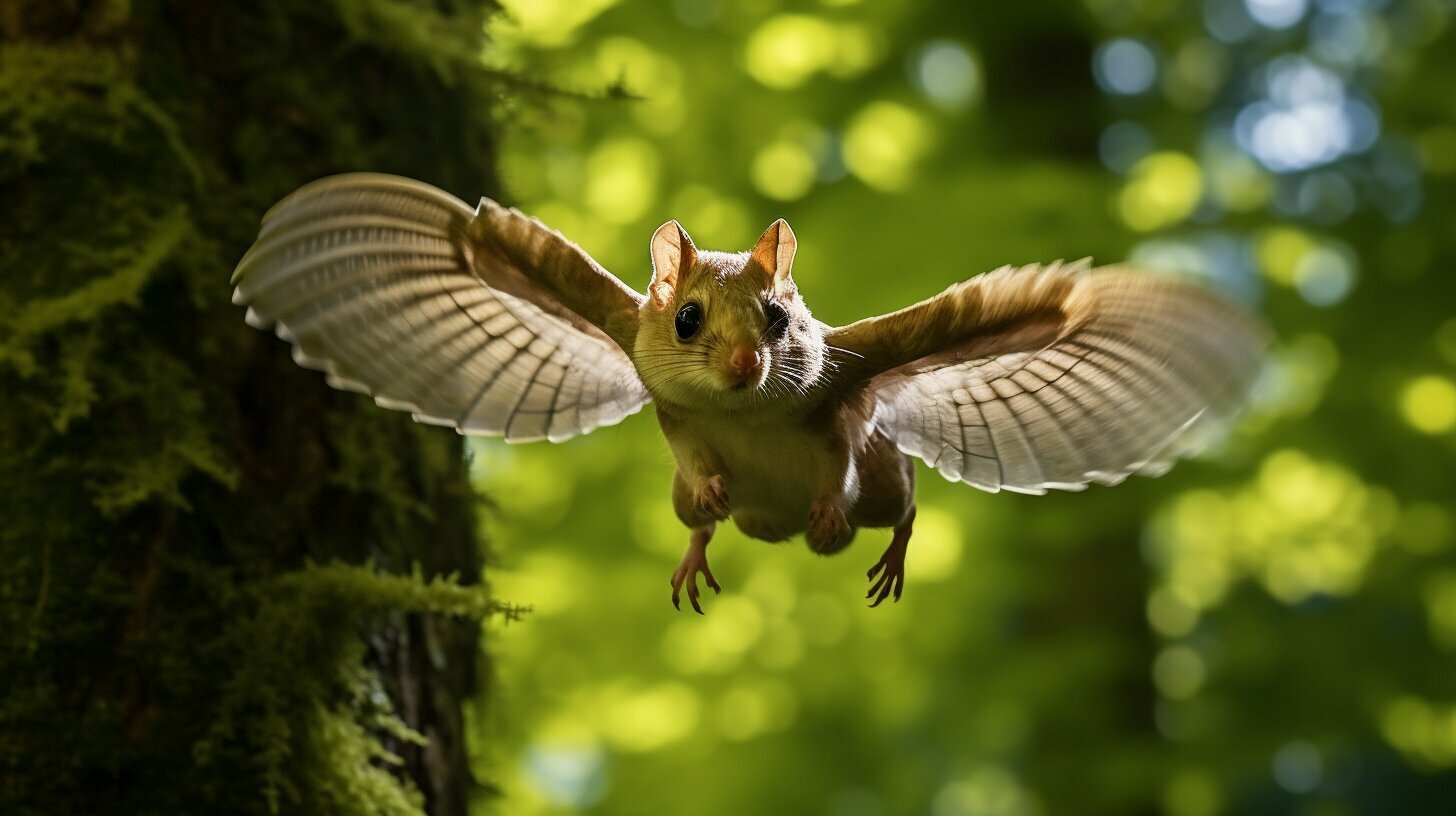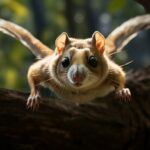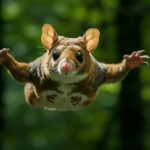Flying squirrels possess remarkable anatomical adaptations that allow them to navigate the skies with ease. These agile creatures are not capable of true flight but instead glide gracefully through the air. Let’s explore the fascinating anatomy that enables flying squirrels to perform these extraordinary aerial maneuvers.
Key Takeaways:
- Flying squirrels are a group of more than 50 gliding squirrel species found across North America, Eurasia, and Asia.
- They have a furry membrane called the patagium that extends from their wrists to their ankles, allowing them to glide through the air.
- Winglets at the tips of their patagium help reduce drag and stabilize their flight.
- The tail of a flying squirrel acts as a steering organ, enabling them to change their course of flight.
- Flying squirrels are nocturnal creatures that live in tree cavities, nests, or rock crevices and have varied diets.
Join us on this journey as we unravel the mysteries of flying squirrel anatomy, from their unique patagium to their versatile tail. Let’s discover the secrets behind their impressive gliding abilities and gain a deeper appreciation for these incredible creatures.
The Magical Patagium: Anatomy of a Flying Squirrel
At the core of a flying squirrel’s unique anatomy is their exceptional patagium, a furry membrane that serves as their gliding apparatus. This remarkable feature allows them to gracefully glide through the air, defying gravity with ease. The patagium extends from their wrists to their ankles, creating a wing-like structure that enables them to navigate the skies with agility.
The patagium is composed of a thin layer of skin, supported by a network of stretchy connective tissue. This structure allows the flying squirrel to stretch its patagium outwards, creating a larger surface area for gliding. When not in use, the patagium folds neatly against its body, minimizing drag and facilitating efficient movement on land.
In addition to the patagium, flying squirrels have fascinating winglets at the tips of their gliding membrane. These winglets are flexible extensions of bone, covered in a layer of specialized skin. They play a crucial role in reducing drag and enhancing flight stability. By adjusting the position of these winglets, flying squirrels can fine-tune their gliding experiences, ensuring a smooth and controlled flight through the forest canopy.
To better understand the wonders of flying squirrel anatomy, here’s a table summarizing their unique physiological characteristics:
| Physiological Characteristics | Description |
|---|---|
| Patagium | Furry membrane that extends from wrists to ankles, used for gliding |
| Winglets | Flexible extensions of bone at the tips of the patagium; reduce drag and enhance flight stability |
| Tail | Serves as a steering organ, allowing for mid-air course adjustments |
| Nocturnal Lifestyle | Adapted to thrive in nocturnal environments, using their unique anatomy to navigate and forage at night |
In conclusion, the anatomy of a flying squirrel is a marvel of evolution, enabling these creatures to glide effortlessly through the air. Their patagium, winglets, and tail work in harmony to provide stability and control during flight. With their exceptional physiological characteristics, flying squirrels have mastered the art of gliding, allowing them to explore their forest habitat with grace and precision.
Wings of Precision: Winglets and Flight Stability
Alongside their patagium, flying squirrels possess winglets and specialized musculature that enhance their flight stability. These unique adaptations allow them to glide effortlessly through the forest canopy, navigating obstacles with precision and grace.
The winglets, which are small projections at the tips of the flying squirrel’s patagium, play a crucial role in reducing drag during flight. They help to minimize turbulence and maintain a smooth glide by reducing the formation of vortices at the edges of the membrane. This aerodynamic advantage allows flying squirrels to maneuver through tight spaces and maintain stability in mid-air.
The musculature of flying squirrels is also tailored to their gliding abilities. Their muscular system is finely tuned to control their patagium and adjust their flight trajectory. The muscles in their limbs and body enable them to make subtle adjustments to their wing shape and position, allowing for precise control and efficient gliding. This specialized musculature ensures that flying squirrels can effortlessly navigate through the forest canopy, even in challenging conditions.
| Adaptation | Function |
|---|---|
| Patagium | Enables gliding by extending from wrists to ankles |
| Winglets | Reduces drag and stabilizes flight |
| Specialized Musculature | Allows for precise control and maneuverability |
In summary, the anatomy of flying squirrels is finely tuned for gliding. Their patagium, winglets, and specialized musculature all work in harmony to enable them to navigate the forest with impressive agility and stability. While the exact mechanism by which they glide is still not fully understood, the remarkable adaptations of flying squirrels continue to captivate researchers and nature enthusiasts alike.
The Versatile Tail: Steering in Mid-Air
The tail of a flying squirrel acts as a remarkable steering organ, providing them with precise control during their glides. This specialized appendage, composed of bones and muscles, plays a crucial role in maneuvering through the air with agility and accuracy.
The skeletal system of a flying squirrel supports the tail, enabling it to move in various directions. The tail consists of flexible vertebrae, allowing for a wide range of motion. By adjusting the position and angle of their tail, flying squirrels can change their course mid-air, effortlessly navigating through dense forest canopies.
Furthermore, the tail’s fluffy fur and broad surface area create additional drag, aiding in slowing down or changing direction during flight. This drag effect, combined with the squirrel’s ability to adjust the position of their tail, allows for exceptional control and stability while gliding through the air.
Glide maneuvers: Tail-assisted flips
In addition to steering, flying squirrels can utilize their tail for advanced glide maneuvers, such as tail-assisted flips. By flicking their tail upward at precise moments, they can execute quick somersault-like flips, adding flair and agility to their gliding performances.
To better understand the versatility and significance of a flying squirrel’s tail, let’s take a closer look at its structure:
| Tail Anatomy | Function |
|---|---|
| Flexible vertebrae | Allows for tail movement in multiple directions |
| Fluffy fur | Increases drag, assisting in controlling speed and direction |
| Broad surface area | Enhances stability and maneuverability during glides |
With their remarkable tail as a steering and maneuvering tool, flying squirrels showcase their acrobatic prowess as they gracefully glide through the air, seamlessly navigating their arboreal habitats.
Nocturnal Homes: Nesting and Habitat Preferences
Flying squirrels seek refuge in tree cavities, nests, or rock crevices, utilizing their physical features to adapt to their nocturnal homes. These unique creatures have a skeletal system that allows them to navigate the intricate environments of forests and rocky landscapes. Their slender bodies, flexible spines, and elongated limbs enable them to squeeze into tight spaces and maneuver through narrow passages.
Their physical features also play a crucial role in their ability to thrive in nocturnal habitats. Flying squirrels have large, forward-facing eyes that provide them with excellent night vision, allowing them to navigate and forage in low light conditions. Their keen sense of hearing helps them detect predators or other potential dangers, ensuring their safety while they explore their surroundings.
Additionally, flying squirrels possess sharp claws that enable them to grip onto tree trunks and branches, providing stability and preventing them from falling while climbing. These specialized claws, along with their nimble movements, allow them to effortlessly navigate their arboreal homes and venture out to find food sources.
| Habitat Preferences | Physical Adaptations |
|---|---|
| In forests | Skeletal system for navigating through trees and leaping between branches |
| In rocky landscapes | Sharp claws for gripping onto rocks and crevices |
| In tree cavities | Slender bodies and flexible spines for squeezing into tight spaces |
In conclusion, flying squirrels have remarkable physical features that enable them to adapt to their nocturnal homes. Their skeletal system, keen senses, and specialized claws allow them to navigate through forests, climb rocky landscapes, and explore tree cavities. These adaptations contribute to their survival and ensure their ability to thrive in the unique environments they call home.
A Varied Diet: Fueling the Gliding Adventures
The anatomical adaptations of flying squirrels allow them to sustain their remarkable gliding abilities through a varied diet that includes seeds, fruit, nuts, fungi, insects, and even small mammals. Their unique physiology enables them to explore and traverse different habitats while ensuring they have ample nutrition to support their energetic lifestyles.
Flying squirrels possess sharp incisors that aid in cracking open nuts and chewing through tough fruit skins. Their agile paws are equipped with strong claws, allowing them to deftly manipulate and grip various food sources. This versatility enables them to access a wide range of edible items in their environment, from succulent berries to hard-shelled acorns.
Their diet is not limited to plant matter alone. Flying squirrels also opportunistically feed on insects and other small animals. These protein-rich meals provide them with the necessary sustenance to maintain their gliding capabilities and overall health. Their sharp eyesight and exceptional agility aid them in hunting and capturing prey in mid-air or on the forest floor.
While they do have preferred food sources, flying squirrels display remarkable dietary flexibility depending on the availability of food throughout the seasons. They are well-adapted to navigate through different environments, allowing them to find sustenance even in challenging times. Their ability to switch between different food sources provides an advantage in situations where their usual dietary options may be scarce.
| Preferred Food Sources | Occasional Food Sources |
|---|---|
| Acorns | Insects |
| Nuts | Small mammals |
| Berries | Bird eggs |
| Fungi | Tree sap |
The diverse diet of flying squirrels not only provides them with the necessary nutrients to enable their gliding adventures but also plays a vital role in maintaining the delicate balance of the forest ecosystem. Their foraging behavior contributes to seed dispersal, aiding in plant reproduction and forest regeneration. This ecological role highlights the importance of their ability to adapt their dietary habits to a changing environment.
Conclusion
Through their extraordinary anatomy, flying squirrels demonstrate the marvels of nature’s design, captivating us with their effortless aerial maneuvers. These fascinating creatures have adapted unique features and physical structures that enable them to glide through the air with grace and agility.
The key to their gliding abilities lies in their specialized body structure, particularly the patagium. This furry membrane extends from their wrists to their ankles, acting as a natural parachute that allows them to glide from tree to tree. With the help of winglets at the tips of their patagium, flying squirrels can reduce drag and maintain stability during flight.
But it doesn’t end there. The tail of a flying squirrel serves as a steering organ, providing them with the ability to change their course while in mid-air. Their skeletal system supports the tail, ensuring precise control over their gliding movements.
Living predominantly in nocturnal habitats, flying squirrels rely on their physical features to thrive in these environments. Their well-adapted skeletal system, along with their keen senses, allows them to navigate through the darkness with ease. They create nests in tree cavities, nests, or rock crevices, providing them with shelter during the daytime.
When it comes to fueling their gliding adventures, flying squirrels have a varied diet. They consume a wide range of foods, including seeds, fruits, nuts, fungi, insects, and even small mammals. Their anatomy plays a crucial role in their foraging abilities, allowing them to gather the necessary energy for their spectacular glides.
In conclusion, flying squirrels are true marvels of nature. Their unique anatomy, with the patagium, winglets, tail, and skeletal system, enables them to perform remarkable aerial maneuvers. While we continue to explore and learn more about these fascinating creatures, their gliding mechanism remains a captivating mystery, adding to their allure.
How Does Flying Squirrel Anatomy Play a Role in the Reproduction Process?
The unique anatomy of flying squirrels plays a crucial role in the flying squirrel reproduction process. The female has a specialized reproductive system that allows for successful fertilization and gestation. This anatomy enables flying squirrels to reproduce effectively and ensure the continuation of their species in their natural habitat.
FAQ
Q: How do flying squirrels glide through the air?
A: Flying squirrels have a furry membrane called the patagium that extends from their wrists to their ankles, allowing them to glide. They use their winglets at the tips of their patagium to reduce drag and stabilize their flight. Their tail acts as a steering organ, enabling them to change their course of flight.
Q: Where do flying squirrels live?
A: Flying squirrels can be found in tree cavities, nests, or rock crevices. They prefer nocturnal habitats and are most commonly found in North America, Eurasia, and Asia.
Q: What do flying squirrels eat?
A: Flying squirrels have varied diets that can include seeds, fruit, nuts, fungi, insects, and small mammals. They have the ability to adapt their diet based on their surroundings and available food sources.
Q: How big are flying squirrels?
A: The sizes of flying squirrels can vary greatly. Some species weigh as little as 3.5 ounces, while others can weigh up to 5.5 pounds. The specific size of a flying squirrel depends on its species.
Q: How many different species of flying squirrels are there?
A: There are approximately 50 different species of flying squirrels. Each species has its own unique characteristics and habitat preferences.
Q: What is the exact mechanism by which flying squirrels glide?
A: The exact mechanism by which flying squirrels glide is still not fully understood. Scientists continue to study and research the intricate details of their anatomy and flight capabilities.











